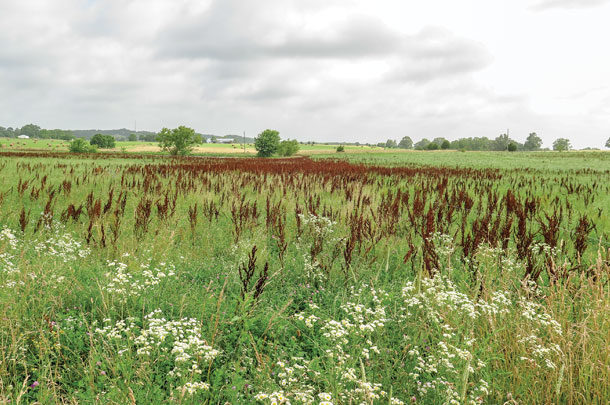Whether herbaceous or woody species, if enough weeds are present in the pasture, the carrying capacity of the management unit is decreased, the nutritive value of the forage base is reduced, and input costs of the enterprise are increased. The result is: Profitability is reduced.
Weed infestation generally occurs due to poor management. Introduced forages, such as bermudagrass, have been selected because of their ability to respond to fertilizer with significant increases in dry matter production. With proper fertility inputs, healthy forage stands usually can outcompete weed species. Under low fertility conditions, however, weed species generally have the competitive advantage.
Poor grazing management, usually overstocking, also contributes to weed infestation. Overstocking occurs when there are more animals per grazing unit relative to the unit’s ability to provide forage. Desirable forages are continuously and heavily grazed without the opportunity to recover and are thus reduced in abundance or frequency.
Since most weed species are generally not as palatable to grazing animals, these species are generally ignored while more pressure is placed on the more desirable species. If this practice continues, a shift in plant species composition from desirable to less desirable species occurs. This change in plant composition is referred to as an overgrazed condition.
Thus, most weeds are a direct result of past mismanagement. Most producers respond to weeds by applying herbicides or mowing. If no change is made in the overall management, however, producers are only treating symptoms and not the direct cause of the problem. In fact, if there are no desirable species present to respond to a release from weed infestation, producers may be left with bare soil following a herbicide application. Thus, in certain situations, a complete renovation of the pasture may be warranted.
As noted, most weed problems can be directly attributed to a lack of fertility coupled with overstocked livestock. Exceptions do occur because of drought. During dry years, reduced forage growth offers weed species the opportunity to become established. If allowed to make seed, the year following a drought can witness a tremendous weed population. In this case, herbicides are usually required to manage the weed infestation.
In monoculture grass pastures, such as bermudagrass, many producers consider any plant other than the grass a weed. If hay is being produced for certain niche markets, such as the horse or dairy industry, relatively pure stands of grass, and thus higher input costs, may be required. For most beef cattle operations, however, pure stands of grass may not be necessary or even desirable.
Many plants routinely mowed or sprayed with herbicides have high nutritive value and are readily consumed by cattle, especially early in the season. The use of good grazing management can encourage cattle to graze certain weed species and minimize either mowing or the use of herbicides.
Chemical management
Usually the first indication of the need for a management strategy is the presence of weed flowers. Unfortunately, by the time weeds become reproductive, it is usually too late to apply herbicide; the weed has removed most of the moisture and nutrients required for that growing season. Some management options may be used to prevent ripening of seed; however, there is probably a large seed bank in the soil to begin with. A better strategy is to be proactive and scout pastures early in the growing season to determine the level of infestation and whether management will be required.
The best weed management program is one of prevention. As discussed previously, proper stocking rate and good fertility encourage vigorous stands of desirable forages able to compete with weed species. Even under the best of management, however, some weed management will be necessary for most hay and livestock operations.
Biological management in pastures would involve the use of grazing livestock to place pressure on weed species at key times in the season. Rotational stocking is necessary to encourage livestock to graze certain plants that would not normally be consumed. This grazing management practice can be quite effective on annual weed species in the early part of their growing season when root reserves are low.
Continued defoliation can drain the plant of its store of energy before an adequate root system is developed and destroy the plant. Obviously, this is not a good practice if toxic plants are the target species. Proper plant identification is critical for effective management of weed species, regardless of the management option.
Chemical (herbicide) management of weed species can be both safe and cost-effective if used appropriately. There are two important steps in using herbicides. The first step is to correctly identify the problem plant. This is important because some herbicides are more effective on certain weed species than others. Correct identification of the target plant helps ensure selection of the most effective herbicide.
The second step in appropriate herbicide use is to follow the label directions. Strict adherence to label directions is required by law. Paying close attention to label directions will also ensure safe, effective and economical use. Herbicide labels contain directions for proper rate and timing of application, a list of susceptible species and information regarding cleanup and disposal. Even if you have used certain herbicides previously, the product label should be checked yearly to determine if any changes have been made regarding application of the product.
Mechanical management
Last on the list is mechanical management. Mechanical methods can be effective in regions where mesquite, huisache and other woody species are problems (i.e., south Texas). In regions where introduced pastures are found, however, mechanical methods are generally less effective and costlier than other options.
Mechanical treatments, mowing or shredding, can make the management of some species like persimmon more difficult. Usually more than one mechanical treatment per season is required. When even two trips across the field with a bush hog are considered, the economic advantage of using herbicides becomes apparent quickly.
Weed infestation is a common discussion topic among landowners and managers. The most commonly perceived solution is to mow and apply herbicide. If weeds are a persistent problem, careful analysis of current management strategies may be necessary to determine the underlying causes for the dilemma. In most instances, management strategies involving use of appropriate stocking rate and a good soil fertility program will do much to alleviate the problem. ![]()
PHOTO: Weeds are usually the symptom of mismanagement and, in many cases, an appropriate stocking rate and a good soil fertility program will do much to alleviate the problem. Staff photo.

-
Vanessa Corriher-Olson
- Associate Professor and Extension Forage Specialist
- Texas A&M AgriLife Research and Extension Center
- Email Vanessa Corriher-Olson
Herbicide cost per acre
At the beginning of 2019, Jason Banta and Vanessa Corriher-Olson released the 2019 Herbicide Cost Per Acre Spreadsheet for Pastures and Hayfields. It is a downloadable spreadsheet (Texas A&M - Forage Fax) that calculates herbicide cost per acre for a partial list of available products. This spreadsheet is intended to serve only as a guide for determining herbicide cost per acre and is not an indicator of product effectiveness or appropriate use.
The herbicide cost per acre spreadsheet should not be the only factor in choosing a product. In addition to cost, the following factors should be considered: weeds controlled, label use restrictions, grazing and harvest restrictions, residual control, potential impacts on other crops that have been or will be planted in the future (e.g., legumes), and environmental impact.











